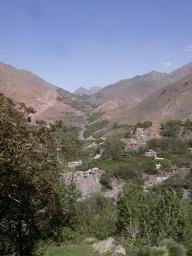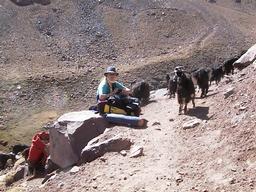

Page: 1 | 2 | 3 | back to first >>
Mathieu, Christophe and Magali took the 7 o'clock train to Rabat to return in France, I continued the grand tour of Morocco with Christelle. Our next plan was to conquer the highest peak of the High Atlas, Mt. Toubkal (4167 m).
We didn't hurry up but at 10.00 we were already in a bus towards Asni. The car was one of those about 30 year old vehicles that wouldn't have any chance to pass the environmental norms in Finland but it made the 50 km distance in two hours and cost only 10 DH per head + 5 DH per backpack and we were happy.
From Asni there's still about 20 km of narrow road to Imlil, the village just below 2000 m where the hiking route starts. As we were only two we were prepared to wait for other people to get a good price for the transport, but were lucky again: there was a minibus waiting for just a few people more to leave. We dug another 15 DH per person from our wallets, hopped in and the journey continued.
A minibus being full is of course a relative matter. Here it was no less than 19 passengers plus the driver in an old Ford Transit van, converted to transport by installing two additional wooden benches in the back. The luggage was placed on the roof but there was still plenty of space: three more people climbed there at the midway to Imlil.
We had set the alarm at 1.00 and were out of the tent equipped with head lamps and backpacks reduced to minimum within 15 minutes. The moon was full and gave enough light for seeing the ground and the shapes of the mountains so we didn't actually need the lamps when we started climbing.
We had a map and an idea where the path should go but of course didn't know the details. The land was rocks and sand so the path was not always easy to distinguish and we lost it several times. Additionally from about 3500 m up the altitude started to have a strong influence. Christelle had done several high peaks before and is probably physically a bit stronger than me but suffered more from the lack of sleep, so we both advanced slowly having breaks frequently.
There were certainly over 100 people in and around the hut but we were the only two crazy enough to do it at night. We sat down, enjoyed the view and started heating up some water. The tea was ready at 6.30 and we had bread, cheese and cookies for breakfast.
There's a tradition to buy a drink to everyone in the group after climbing the first 4000 m peak. For me it was a bargain, going down didn't take long and we were soon eating chocolate cookies and drinking coke in the hut while many others were still having their breakfast.

|
You can't avoid encountering goats and sheep in Morocco, they are everywhere. Even on the main highways it isn't rare to see a shepard traversing the road with his herd. |
We were back at Imlil at noon, got a ride on a small truck (not in the cabin) down to Asni paying the standard price 15 DH / person and continued to Marrakech by a minibus which this time was quite modern and comfortable. After spending yet another 15 DH (for the two) for a taxi we were again at "home", the terrace of hotel Farouk.
The Medina of Meknes is rather small but sympathetic and not the easiest place to find your way around. On our second try we found the entrance to the Medersa Bou Inania (14th century). The medersas were sorts of religious universities where the students got education on politics, justice and religion (Islam) and also lived. Quite a few still exist, some of them in bad condition however.
Among other less interesting shops we found a wonderful bakery and bought a box of about 300 g of cookies and chocolates for only 20 DH. We had also planned to visit the museum of old handcrafts and ethnography but unfortunately it was closed due to renovation work.
Friday morning we got yet another good example of the effectiveness of the Moroccan transport system. When we asked the hotel what would be the best way to get to Fes about 50 km away they said that there are buses all the day and they stop right in front of the hotel if you wave them. He was right, the bus arrived in 5 minutes and 45 minutes later we were at Fes paying 10 DH each. Cool.
The biggest advantage of Friday was that all the doors of the mosque in the center were open. As non-muslims we couldn't enter but were able to see inside rather well. Like in almost all the other cities the mosque of Fes is tightly surrounded by small alleys full of merchants and you can't actually see the building even though it is big enough for 24000 people. It's the same thing with medersas and other attractions, you have to study the map closely to find the often modest entrances. That was one of the biggest surprises for me, I had thought of mosques as big buildings with empty space around them, impossible to miss.
We spent a good part of the day visiting various sights: medersas Attarine and Cherratine (Bou Inania was closed), the museum of woodcraft at square Nejjarine and the museum of arts and traditions Dar Batha. The last one was a bit disappointing and medersa Cherratine in awfully bad condition, two others worth a visit. All the museums and visits cost 10 DH per head regardless of the size and state of the place.
When we got the bus station it was 16.10 and a guy was yelling "Meknes, Meknes!" We thought that good, the 16.00 bus hasn't left yet, paid and got in. Actually the bus didn't leave before 17.30 and we could see the modern airconditioned CTM to get on the way 16.30. Lesson learned: always ask for the time of departure before paying.
On Sunday I visited the family of my roommate in Lyon. He couldn't return home during the vacation but I was warmly invited when I called a few days earlier. They were nice people but unfortunately the visit was partly spoiled by me becoming sick again already in the beginning. I will have to come back another day in better shape, this time I was barely able to take the taxi back to Rabat and late in the evening the bus back to Lyon.
Despite a few personal health problems the trip to Morocco was a success and an experience I will remember. Beautiful nature, nice people, and a feeling that even though some things like the traffic appear to be disorganised they usually work rather well. The father of Christelle and Magali said something along these lines: "Be careful but don't worry too much, you won't get into trouble in Morocco. Or if you do that's really bad luck then."
Page: 1 | 2 | 3 | back to first >>
Last update 17.8.2001.